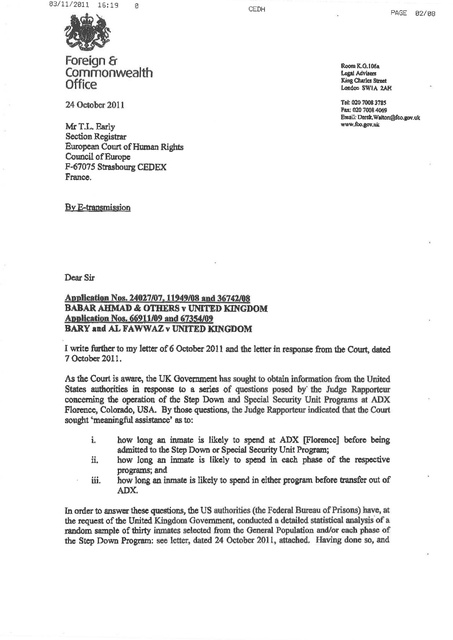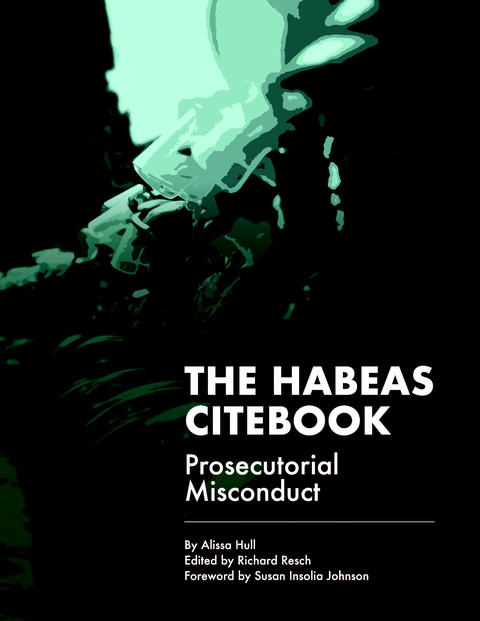Us Uk Correspond Post Ecthr Questions Oct 2011
Download original document:

Document text

Document text
This text is machine-read, and may contain errors. Check the original document to verify accuracy.
03/11/2011
16:19
0
CEDH
Foreign &
Commonwealth
Office
PAGE
02/08
Room K.0.106.
LcpI Advbcn
King Cllarles Stn:ct
London SW1A 2.AH
24 October 2011
Tel: 020 7008 378$
Pu: 020 7008 4069
ElII8U: Doret. W..ton@fco.p.uk
Mr T.L. Early
Section Registrar
European Court of Human Rights
Council of Europe
F·67075 Strasbourg CEDEX
France.
www.fllo.p.u.k
Bv E-transmission
DcarSir
AppUeatl.D NO!. 240271073 1194'/08 aDd 36741101
RABAR AHMAD & OTHERS v UNITED kINGDOM
ARplieation Nos. 66211109 aDd 67354102
BARY anct AL FAWWAZ v UNITED KINGDOM
I write further to my letter of 6 October 2011 and the letter in response from the Court, dated
7 October 2011.
As the Court is awarCt the UK Government has sought to obtain information from the Urtited
States authorities in response to a series of questions posed by' the Judge Rapporteur
concerning the operation of the Step Down and Special Security Unit Programs at ADX
Florence, Colorado, USA. By those questions, the Judge Rapporteur indicated that the Court
sought 'meaningful assistance' as to:
i.
ii.
iii.
how long an inmate is likely to spend at ADX [Florence] before being
admitted to the Step Down or Special Security Unit Program;
how long an inmate is likely to spend in each phase of the respective
programs; and
how long an inmate is likely to spend in either program before transfer out of
ADX.
In order to answer these questions, the US aqthorities (the Federal Bureau of Prisons) have, at
the request of the United Kingdom Government, conducted a detailed statistical analysis' of a
random sample of thirty inmates selected from the General Population and/or each phase of
the Step Down Program: see lettert dated 24 October 2011, attached. Having done so, and
03 / 11/2011
15:19
o
CEDH
PAGE
with the caVeats and restrictions set out in the attached letter from the US DoJ, the answen to
the Judge Rapporteur's questions are, with respect to the StejJ Down Pro!lQ'am. as follows:
i.
How long an inmate is likely to spend at ADX [Florence] before being
admitted to the Step Down or Special Security Unit Program?
Answer: 3 yean.
ii.
How long is an inmate likely to spend in each pbase of the respective
programs?
Answer:
Intermediate phase: , months
Tranlitlonal phue: 11 menths
Pre-Tl'BIISfer pbase: 9 month,
iii.
How long an inmate is likely to spend in either program before transfer out of
ADX?
Answer: 3 years iD the General Population follewed by 2 years 5 months
'progressing' throup the Step Down Procram.
Insofar as the Special Security Unit is concerned, the US DoJ bas explained that the US
authorities are unable to provide similar information on account of inter alia security
con.cerns and on-going litigation in the US: see letter attached. Accordingly, insofar as those
procedures are concerned, the UK. Government relies on its earlier observations~ see most
recently Observations) dated 27 September 2011, Parts 2 & 3.
Yours faithfully
Derek Walton
(Agent for the Government of
the United Kingdom)
03 / 08
03/11/2011
o
16:19
'
e
. .
,
CEDH
•
h '
P i
PAGE
i
•
:aw ,
hi: 4'1
. 'i. (
i ..
U.S. Department of Justiee
.
CrinUna1 Division
l'aMl.", D.C. 2DSJ()
October 24~ 2()11
Mr. Julian OI'bbs
Home Office
5th Floor, Fry Building
2 Matsham S1reel
London. England SW1P 4DF
Re:
Extradition of~ Ahmad. HaroOA AsW8t Syed Tal.b.B Ahsan. and
Mumta Kamel MJwafa (Abu Harnza)
AppDcatfODlIlO.: 24027107 Ahmad and Antat Y. the United KiDgdom
11949108 Ahaan v. the United KIIlIdom
. 36742108 Mustafa (abu Hamza) v. the Uldted KblgdoDl (No.2)
Daar Mr. Gibbs:
This is in response to your letter posed by the Judge Rapporteur at the European Court of
Human Rights (ECtHR) (see letters to the UK. Oovernment dated 9 September 2011, 29
September 2011, and 6 October 2011) and further to my last letter addressing these issues, dated
26 September 2011.
The following responsiVe information was provided by officials at the Federal Bureau of
Prisons·Q30P). Aeoording to BOP officials, the infonnatiollihat the BCtHR is seeking is not
maintained by the BOP in the ordinary course ofbusiness. The nop recejves requests for this
infonnation in criminal and eivillitigatioo. hi each instanccJ the BOP objects to the ~ueat,
arguing, among other things, (1) the BOP does not maintain the infonnation in the form
requested, in 1hc ordinary course of the age~cy's business; (2) the compilation, lISSimilation~ and
synthesization o!voluminous records to provide the infcnnation in the fonn sought would cause
the agency to' expend substantial time and resources, ~urring undue expense; (3) 1he
information sought is coofidential and privileged (5 U.S.C. § SS:2(b)(7)(E»); and (4) such
inf~ beaJ:s on the fwlction and security of the United States' most secure penal
institution. The courts routinely sustain the obje<:tionfinding (1) the request to be oppressive
and requiring excessive amounts of research and compilation of data at great expense that bas no
direct bearlng on the ItI.81tm"s at issue; and (2) the disclosure of the information woQld
compromise the integrity of the Step-Down Program, the Special Administrative Measures
(SAMs) prog~lUIl, and the Special Security Unit Prognun, in detriment to the DepartInent of
•
"
04/08
03/11/2011
,
li
15:19
o
CEDH
,
- -,. -- ( 'r 'M' "
PAGE
i.
_ . ~.
....
OI •
Justice's various law enforoement missions. See, e.g., Rfj?.Ag y. Nalley. No; 07-cv-02483-LTBKLM (D. Colo.); Saleh. et aI. y. Federal Bureau of PrlsODS. Nos. OS-cv-02467.PAB-J{LM. 06-ovOI747·PAB-KLM, 07-cv-00021-PAB-KLM (0. Colo.)~ An'Jd. ;tal. y. Holder. Nos. OS-cv·
2342-WYD-MJW, 05-ev-02653-WYD-M1W (O. Colo.); USA v. Buciano. No. 05-cr-060
(E.D.N.Y.)~ USA v. Breeden. 3:03-cr·OOO13·SGW (W.D. Va.); USA y. Sabakian. et a) .. No,
1:03-cr-0018~ (S.D.m.); USA y. NYlDlipani; No. cr..()2-2S6 (D.C. Cir.); USA v. Lee. No.
97..a--243 (E.D. Ark.); USA y. Johnson. No. 96-cr-379 (N.D. 01.).
NeverthelCSSt in an effort to cooperate with the ECtHR and without waiving 1hc abovestated :objections, BOP officials again reviewed the request to determine what responsive
information could be gathered and provided without being oppressive and unduly burdensome
and compromising the integrity of the Step"Down Program, the SAMs program, and the Special
Secmity Unit program. They dotenniIlcd, without waiving 1he objection stated above; that BOP
staff could randomly select thirty (30) inmates 'who are currently in the General Population
and/or three phases of the Step-Down Program (Program) mid conduct an extensive mmuai
review of compU1erized records for eGh of the thirty inmates to provide information. responsive
to the reque.«. Thill would result in a review of close to l00A of the inmates currently housed in
the Qenciral Population and Program units.
Wi1h regard to information regarding inmates housed in the Special Security Unit.
howeverJ BOP officials determined that, for the objections mentioned above, they will not be
able to provide any additional information. Moreover. there is still open and active civil
litigation on many of the issues SUl1'Ounding the management of those inmates with SAMs at the
ADX. A tcqucst for suM information was·made in those matters. BOP officials objected to the
request for the reasons stated above, and the objection was sustained. .
.
Accordingly, BOP staff proceeded with the random. selection and exteDsi.ve review of30
imnates housed in the: General Population and Program units at the ADX. Of those 30 inmms
raruromly selecmd, 10 are CUl"l'Mtly in the General Population; seven are currently in the
Intennedlate phase; six are currently in the Transitional phase; and seven. are currently in the PreTransfer phase. The results oftbe review are as foUows:
2
•
I
, _,
05/08
-.
t9
W
"-
I-'
.....
"-
'",.....
c;;)
I-'
I-'
en
lnmate .
1
2
3
4
5
6
7
8
9
10
11
12
13
14
15
16
17
18
19
20
21
22
23
24
2S
26
27
28
29
30
GerteraI Population
7 yeaws, 10 rnonttIs*
Intermediate
Pfe-oTransfer
Transitional
lmonth*
5 years, 10 moJ'IltIs
1 year~ 6 months
5 years, 11 months
2 years, 8 months*
3.!iye8rs
3 years
4years*
4years*
3 years, 2 manthS*
1~1' 7 months
4 years
2.5 years
3 years
4 yeBf'5f 4 monU1S*
1 year, 4 months
1 year, 6 months
2 years"
3 years
LD
c;;)
N
N
N
N
7 monthS
2.Syears
2 years
3 years, 2 montbs*
I-'
N
N
8montbs
3 years, 6 months
3 years, 5 months
3 years, 2 months
4 years, 7 months
5 years
PRIOR SAM(YJN)
N
N
N
Y
N
N
N
6 months
1 month
1 month
1~1 2 months*
2 years, 10 months*
1 month
1 month
lyecir*
lyear*
lyeat*
6 months
6 months.
7 months
2 years
N
N
5 months*
N
N
1 year, 1 JIJlJIth*
N
tyear*
N
11 months'"
61J1011lhs
N
N
N
N
N
6 months
4 months
8 months
1 yeeI, 4 months*
7 months
7 months
1 year*
6 months
6 months
1 year*
1~
1 year
1 year5 months
lyeat
6 months
. 7 months
3 years
6 months
1 year
Smooths
0
.I
fTI
t:I
I
N
N
Y
N
N
N
3
-u
D
GJ
fTI
t9
en
: .- - 7 ' -
-,-.. ..•- .
,_
- . ..
.. .
"'
t9
"-=-".
aJ
03/11/2011
15:19
o
CEDH
. . ... .
~
,
PAGE
,
I, • . . \
Based aD the above random sample, the average time an inmate is in a General
'Population Unit before beiDa placed into the Intermediate phase ofthc Program is tbrcc yCBl'S;
the average time an inmate is in the Intel1D.edia1e phase of the Program. before being placed into
the Transitional phase is nino months,; and the average time an inmate is in the Transitional
phase before being placed into the Pre-Transfer phase is 11 months. Six of the seven inmates
currently in the Pre-Transfer pbase are awaiting redesignation and transrer to another
institution. Based on the above random S8lDple, the average time an inmate must wait in the PreTransfer phase to be approved for transfer and to begin to await redesi.gnati.on is nine months.
Accordingly, based on the random sample, the average time it takes an inmate to
advance through the General Population and each of the phases of the Program before being
approved for transfer is five years, five months.
.
There arc a number of variables which impact the a.verages from. the random sample:
a.
Seven of the 30 inmates randomly selected failed the Program and were returned to the
General Population to start the Program over. Those seven illmates !U'C identified above
with a tl.11 by the amount of time they spent in General Population and/or a particular
phase of the Program. The amount of time indicated for these inmates reflects the total
amount of time they spent in the General Population and/or applicable Program phases.
In addition, each of the seven inmates spent time in the Special Housing Unit following
his removal from the Program and prior to his return to the General. Population. The time
in Special Housing UBit was included in the total for his time in the General
Population. Each of these raised the overall average of time spent in the General
Population and applicable Prognm phases of this random sampJe. Six of these seven
inmates have begun their second time through the phases of tire Program. Two of
tho~ six inmates are in the Pre-Transfer phase of the Program. Two of those &ix inmates
are in Transitional pbase oftha Program. The remaining two oftbose six inmates are
currently in the Intermediate Phase of the Prognun.
h.
Six ofthc 30 inmates randomly selected were away from the ADX on writs and
temporary-transfers to BOP medical facilities ranginS from one to two years. The time on
writ and temporary transfer WIlS not subtracted from the total time spent in the
General Population and, if applicable, the Program phases. This raised the overall
average time spent in the General Population and applicable Program phases of this
random sample.
c.
Other issues also impacted the amount oftime spent by the inmates nmdomly selected in
the General Population and, jf applicable, the Program phases. These issues include. but
are Dot limited to: disciplinary reports received by the inmate while at the ADX; poor
interactio.DS with staff' at the ADX; poor interactions with other inmates at the ADX;
refusal to fullow programming recommendations of his Unit Team~ poor overall
institutional adju~t including, but not limited to~ personal hygiene and cell sanitation;'
the reason(s) the inmate was designated to the ADX; the inmate's criminal history; the
4
•
07/ 08
03/11/2011
\
,
15:19
..
o
t :: •
CEDH
•
.u
PAGE
08/08
i " ~ . ..
4
inmate's involvement with criminal organizations, if any, and the potential safety and
security threat(s) implicated by such involvement; the inmate's overall adjustment duri.11g
his history of confinement; the illStitution's safety and security needs, includiuS the safety
and security of staff; the satety and security needs of the hunate; the safety and security
needs of other inmates; the safety and security needs of the public.
d.
Two of th., 30 inmates randomly selected did. bave SAMs and "We.-e housed in the Speeial
Security Unit when they first aalved at the ADX. One of thDSc two inmates is currently
in 1he Pre-Transfer phase of the Program. This mate was housed in the Special Security
Unit for six months. He was removed from the Spociai Security Unit when his SAM was
vacated by the Attorney General. He was then placed into a General Population Unit at
the ADX. He is awaiting redesignation and transfer to another institution. The other
inmate who iDitially had SAM when he arrived at the ADX and who' is cunently housed
in the General Population at the ADX. was housed in th~ Special Security Unit for 13
months. He too was removed from the Special Security Unit when. his SAM was vacated.
by the Attorney General.
If you have any fiJrth« questions OD these cases, please do not hesitate to contact us.
•..
Sincerely.
Mary Ellen Warlow
Director
BY: .~~
Lystra O. Blake
Associate Directqr
5
I,





